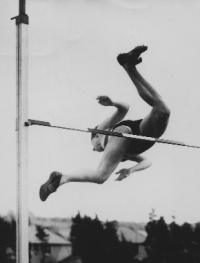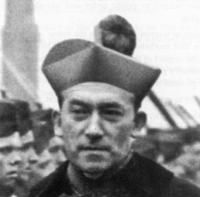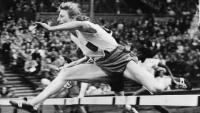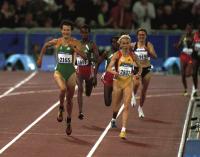Irish women’s athletics and the Olympic Games
Published in 20th-century / Contemporary History, Features, Issue 4 (July/August 2012), Volume 20
Thelma Hopkins’s world-record high jump at the Cherryvale sports grounds, Queen’s University, Belfast, in May 1956. Women had been running and jumping in public from as early as the 1890s. (Seán and Maeve Kyle)
The first step towards organising international athletics for women was taken in May 1921, when some 300 athletes from Italy, Norway, Switzerland, England and France competed at the Olympiades Feminines held in the glamorous surroundings of Monte Carlo. Mary Lines, a 27-year-old Lyon’s Corner House waitress, proved the star of the games and, with rapturous accounts in the British press, athletics captured the imagination of Sophie Eliott-Lynn (née Peirce-Evans) and a generation of young women. In Ireland that summer Sophie competed at meets in Dublin and in high jump exhibitions in Moate, Birr and Ballygar. In Ballygar, Co. Galway, her height of 4ft 9in. (1.447m), jumped scissors-style onto hard ground, equalled the best known performance in the world at that time—though still below the heights achieved unofficially by Ellen Leahy over twenty years earlier (see sidebar opposite).
Women’s Amateur Athletic Association
When she moved to London in 1922, Eliott-Lynn immediately became a founding member of the Women’s Amateur Athletic Association. She travelled with British teams to meets in Paris and Scandinavia and represented the WAAA at International Olympic Council meetings. In August 1923 she set a disputed world record for the high jump of 1.48m at Brentwood, London, just a few weeks after she had won the javelin at the first-ever WAAA championships. Her book Athletics for women and girls (1925) enthusiastically promoted athletics as the ideal sport for women. Women continued to compete over varied sprint distances, from 75yds to 220yds, at sports days during the 1920s. In 1926 the first all-girls sports took place in St James’s Park, Dublin, with the 100yds, 220yds and high jump the three events contested. A year later the Northern Ireland AAA held its first championship races for women, while the NACAI’s Ulster championships included women’s events. Setting the pace in the pentathlon—80m hurdles, high jump, long jump, shot and 200m—were Nancy Lindsay from Lisburn and Ruth McGregor.

John Charles McQuaid stated that women competing in the same sporting arenas as men was ‘un-Irish and un-Catholic’.
Opposition from John Charles McQuaid
In 1928 women athletes first competed in a controversially restricted programme at the Amsterdam Olympic Games. The 1930s were to be a golden era for Irish female sprinters, although the split in Irish athletics (see pp 30–3) meant that these women rarely competed abroad. So well established was women’s athletics in Ireland that a motion to include 100yds, 440yds, 80yds hurdles and long jump for women at their championships was presented to the 1934 congress of the NACAI, then the ruling body for the sport in Ireland. It ran into a storm of protest; indeed, the clouds had been gathering since 1928, when an Irish Times editorial on ‘women athletes’ on 4 May supported comments by Pope Pius XI on the subject. While traditional forms of sport for women, such as tennis, golf and swimming were deemed acceptable, ‘many girls are devoting themselves to public sports which demand violent exertion and sometimes, it would seem, a notable scantiness of clothing . . . These performances are done before crowds of male spectators’. This was followed by an encyclical letter from the pope on much the same subject a year later. It should therefore have come as no surprise that the motion to the NACAI congress provoked fierce opposition, with Monsignor John Charles McQuaid, then president of Blackrock College, Dublin, leading the charge. In a letter to the NACAI, McQuaid stated that if mixed athletics was accepted, no Blackrock boys would join the organisation. Women competing in the same sporting arenas as men was ‘un-Irish and un-Catholic’, he said. Mixed athletics was a ‘social abuse’ and a ‘moral abuse’. He quoted the encyclical letter of Pope Pius XI:
‘In athletic sports and exercises, wherein the Christian modesty of girls must be, in a special way, safeguarded, for it is supremely unbecoming that they flaunt themselves and display themselves before the eyes of all’.
That view was echoed by Dr Magnier of Cork and Padraig O’Keeffe, general secretary of the GAA.Not everyone agreed. W.M. O’Brien of Clare felt that although the pope had objected to women taking part in the tug-o’-war, and in wrestling and boxing competitions, he did not object to them taking part in the lighter forms of athletics, such as running and jumping. As far as he was concerned, freer mingling of the sexes on the athletic field would do good. An Ulsterman, Mr O’Reilly, said that in Northern Ireland women had been competing in athletic contests for a long time. Public opinion was so much against it, however, that the GAA in Antrim had to prevent women athletes from appearing in Corrigan Park in anything but gym dresses. Eileen Bolger was, according to the Irish Press, a well-known Irish runner. She did not see what exception could be taken to girls competing in reserved events. A 100yds championship for girls was held annually at the civil service sports, and an event for girls was included in the Garda sports competition. J.J. McGilton, secretary of the NACAI, supported this development; until the 1930s women had competed in reserved events at men’s meetings with no objections raised.
Fanny Blankers Koen, 1948
Despite those more reasonable views, the matter was dropped after McQuaid’s opinion was made public in a letter to the Irish Times. Matters were not helped by the economic depression, the international turmoil that led to World War II and the internal disputes in the athletics community that kept Ireland out of the 1936 Olympic Games. Women’s athletics fell dormant until 1948, when Fanny Blankers Koen became an international superstar with her four gold medals at the London Olympics. Visits to Dublin and Belfast by the ‘Flying Dutchwoman’ were received rapturously. In Dublin, Pat Kennedy from Belfast finished a distant second behind Blankers Koen over 100m and 200m. At the same time, a team of West Indian women sprinters, on their way home from the games, stopped off in Belfast. A local team was hastily put together and from this grew the women’s section of Short and Harland’s. A year earlier, the annual meeting of Crusaders Athletics Club in Dublin had voted to establish a women’s section, with Pam Kelly as its first president. By the end of 1949 the club had thirteen senior and seven junior members. McQuaid, by now archbishop of Dublin, made his views known in a Lenten pastoral letter that attacked mixed marriages, atheistic communism, pony-racing on Sundays—and young women competing in mixed cycling and athletics sports. In March 1951 the Crusaders ladies section was discontinued, officially because ‘it has no real prospects’. Not until April 1962 did Crusaders finally establish a fully working women’s section.

Fanny Blankers Koen—the ‘Flying Dutchwoman’ was rapturously received on visits to Dublin and Belfast after the 1948 London Olympics.
Women’s athletics finally recognised in the 1960s
In August 1963, women’s events were included in a match against Belgium and Scotland. Competing for Ireland were Maeve Kyle, Lorna McGarvey and Mary Peters from the North, Jackie Spence and Peggy Hogan of Crusaders and Claire Dowling of Clonliffe Harriers. Wins for Mary Peters in the high jump and shot sealed a famous victory for the Irish team. Three months later, in November 1963, athletics impresario Billy Morton organised a meeting for budding women athletes in Moran’s Hotel, Dublin. From that came the women’s section of Clonliffe Harriers. Dublin University [Trinity College] Harriers and Athletic Club (DUHAC) was next to establish a women’s section, with Lil Ganley its first captain. In 1965 DUHAC won its first team competition in a triangular match with Clonliffe and Crusaders.Only in April 1965 did the NACAI congress in Dublin finally pass motions approving the introduction of competition for women athletes. Not all Irish clubs were attached to the NACAI: a sizeable number, most of them in Dublin, were attached to the Amateur Athletic Union (AAU). At the first AAU women’s meet in 1965, Claire Dowling of Clonliffe won the 220yds, the 440yds and the long jump; winners for Crusaders were Hazel Tennison in the 880yds and Peggy Hogan in the mile. A year later, Hogan became the first-ever Irish women’s cross-country champion.

Sonia O’Sullivan winning the silver medal in the 5000m behind Gabriela Szabo of Romania at the 2000 Sydney Olympics—by then the big stars of Irish athletics were female. (Sportsfile)
Irish women athletes at the Olympics
From 1965 to 1972 Claire Dowling-Walsh and Ann O’Brien, both of Clonliffe, dominated Irish women’s athletics, winning 37 national titles between them. In 1972 Mary Tracey (Purcell) of the now defunct Guinness club burst onto the scene when she clocked a time of 2:04.2 for 800m. Tracey, unbeaten on home soil from 1972 to 1976, was her country’s first truly world-class female athlete, winning a number of British titles as well as competing at the Olympic Games of 1972 and 1976. Perhaps her most ground-breaking run came in 1978 at the UCD track in Belfield when she entered a men’s 5000m, dropping out at 3000m with a time of 8:51.4—the fastest ever by an Irishwoman over this new distance. Away from the track, at the 1979 World Cross-Country Championships in Limerick she finished a magnificent sixth in the women’s race. Her achievement was eclipsed only by the victory of a certain John Treacy in the men’s race.Another mould-breaking athlete was sprinter Michelle Walsh-Carroll, winner of 31 national titles between 1977 and 1995, mostly for the 100m, 200m and 400m but also in the 800m. Her Irish 100m record of 11.43 seconds, set in 1978 when she was seventeen, was only bettered in 2010. Other inspiring female athletes of that era included the versatile Deirdre Foreman-Nagle, with Irish titles in the 800m, 1500m and 3000m, cross-country and marathon, and Emily Dowling, who won the second Dublin City Marathon in 1981. At the 1984 Olympics in Los Angeles, Caroline O’Shea became the first Irish female athlete to make an Olympic final. She finished eighth in 2:00.77—just outside her own record. At those same games Waterford discus-thrower Patricia Walsh became the first Irish woman to qualify for a field event final, coming ninth with a throw of 55.38m. When the athletics establishment finally accepted women’s marathon running, Dubliner Carey May took up the baton, winning her debut marathon in Letterkenny in 1980. She followed this up later that year with victory in 2 hours 42 minutes 11 seconds at the inaugural Dublin City Marathon. A year later she became Ireland’s first official female marathon champion at the Irish Marathon Championships in Cork. Her finest moment came at the women-only Osaka Marathon in Japan. In her first run at this race in January 1983, May set a new Irish record of 2 hours 29 minutes 23 seconds. She improved that to 2:28.07 a year later. It would remain the Irish record until September 1997, when Catherina McKiernan ran the Berlin Marathon in 2:23.44.By then the big stars of Irish athletics were female, led by Sonia O’Sullivan, Olympic silver medallist in 2000, and McKiernan. Slightly later came world indoor champion hurdler Derval O’Rourke, and race walkers Gillian O’Sullivan and Olive Loughnane, who both picked up world medals. A crucial element in the story was the success of the Dublin Women’s Mini-Marathon, which saw 8,000 women take to the streets of Dublin in 1983 and encouraged women and girls in their thousands to get fit and take up running. With girls now outnumbering boys in athletics clubs all over the country, the production line of Ireland’s female athletics talent is unlikely to stop anytime soon. HI
Lindie Naughton is a Dublin journalist and writer with a particular interest in early twentieth-century history.
Further reading:
J.W. Brant, Irish women’s athletics 1891–1946: so there was none? (J.W. Brant, 2000).E.L. Cowe, International women’s athletics 1890–1940 (Bingley, 1985).L. Naughton, Lady Icarus: the life of Irish aviator Lady Mary Heath (Dublin, 2004).L. Naughton & J. Watterson, Faster, higher, stronger—a history of Ireland’s Olympians (Dublin, 2008).
















